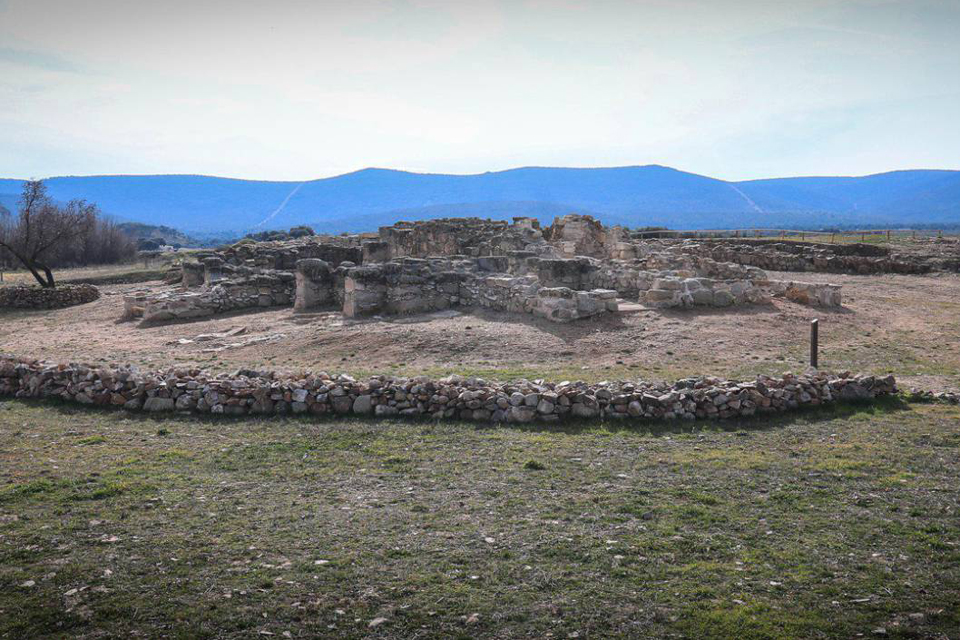REVIEW: New book on “Ecclesiastical Landscapes” aims to explore the diversity and unity of how churches and monasteries set their mark on their surrounding landscape.
Ecclesiastical Landscapes in Medieval Europe: An Archaeological Perspective
Ed. by José C. Sánchez-Pardo, Emmet H. Marron, and Maria Crîngaci Ţiplic.
Archeopress 2020
Medieval churches and monasteries are some of our best preserved and most thoroughly studied medieval structures. Numerous excavations and art historical surveys have provided a vast and literally bottomless resource of articles, books, and visual imagery as to the architecture, spatial organisation, ornamental embellishments, soundscapes and emotionality of the heart of the Christian Church.
Less studied, though, has been how these Christian buildings “influenced – and were influenced by their surrounding landscapes in physical, economic, political and symbolic terms.”
A new book edited by three historians and archaeologists from Spain, Ireland, and Romania aims to explore this new and exciting field, which has hitherto played a more peripheral role.
By presenting case studies from across eastern and western medieval Europe, Ecclesiastical Landscapes in Medieval Europe aims to start a Europe-wide debate on the variety of relations and contexts between ecclesiastical buildings and their surrounding landscapes between the 5th and 15th centuries AD.
The book contains 16 papers dealing with 11 very diverse regions: Transylvania, Western Bohemia, Switzerland, Tuscany, the Po Valley, Central Spain, Galicia, England, Scotland, the Isle of Man, and Ireland. One of the more specific goals has been to overcome the often tacit idea that East and central Europe differs from that of the Western and Northern parts. Unfortunately, though, Scandinavia, Germany and France lack from the collection.
One of the more interesting questions, which are explored here, is the role, which changing social structures and new elites and episcopacies came to play in the transition from the earliest pantheons in urban cemeteries to patrimonial churches next to the manorial centres. But also the significant role which the new monasteries came to play in terms of invigorating the countryside as a Christian – sometimes paradisiac – landscape, such as may have been encapsulated in the Cistercian foundations of the 12th and 13th centuries. In connection with this one of the contributors, James Bond, provides a whole new set of observations on the changes to horticulture and monastic gardens. At the same time, Marco Panato offers the reader an inroad into the sacred wilderness of the Veneto region. Finally, the management and manipulation of water resources play a significant role in the contribution of monasteries in Transylvania.
This book is a welcome contribution to the current focus on landscapes as an essential part of the medieval world. As modern historians, we have difficulty imagining both the closeness of medieval communities, and the human need to transgress the boundaries to trade as well as to seek spiritual consolation. Also, we tend to forget the nearly superhuman effort, it took to erect churches, dig a grave, or plant and nurture an orchard.
This book offers a welcome input to this imaginative effort, which we have to muster whenever we try to visualise the lives of our medieval ancestors. Also, it sets the spotlight on the diversity of histories from different parts of medieval Europe.
Table of Contents
Introduction: Towards an Archaeological Study of Medieval Ecclesiastical Landscapes in Europe – José Carlos Sánchez-Pardo, Emmet H. Marron and Maria Crîngaci Țiplic
FIRST PART: ECCLESIASTICAL TOPOGRAPHIES
1. Lesser Churches, Kin-groups and Communities in the Early Middle Ages: Archaeological Evidence from Corcu Duibne, Ireland – Tomás Ó Carragáin
2. By Land and Sea: Medieval Places and Ways of Faith in the Isle of Man – Andrew Johnson
3. The Late Antique Ecclesiastical Settlement of Los Hitos and the Rural Landscapes of the Visigoth Capital (Toledo, Spain) – Isabel Sánchez Ramos and Jorge Morín de Pablos
4. Landscapes of Christianisation. The Emergence and Evolution of Church Power in the Tuscan Countryside During Late Antiquity and the Early Middle Ages – Gabriele Castiglia, Stefano Bertoldi and Cristina Menghini
5. Christianization and Transformation of Religious Landscape in (West) Bohemia – Martin Čechura
6. The Rise of the Parish System in Transylvania as Reflected by the Archaeological Discoveries – Maria Crîngaci Țiplic
7. Architectural Interferences in Medieval Transylvania (13th–15th Centuries): the Archaeology of Orthodox Churches in a Catholic Landscape – Daniela Marcu Istrate
8. The Archaeology of Romanesque Churches in Transylvania (11th–13th Centuries) – Ioan Marian Țiplic and Maria Crîngaci Țiplic
SECOND PART: MONASTIC LANDSCAPES
9. Monastic Landscapes in the Isle of Man: Ad 1100 to 1540 – Peter Davey
10. On the Edge: Excavations at Whitefriars, Perth, 2014-2017 – Derek Hall
11. Cistercian Rievaulx Abbey and the ‘Transformation’ of King Henry II’s Wasteland – Freya Horsfield
12. Evolution, Innovation and Symbolism in Medieval Monastic Gardens – James Bond
13. Ecclesiastical Landscapes in early Medieval Galicia: Physical and Symbolic Transformations – José Carlos Sánchez-Pardo and Marco V. García Quintela
14. Stone Building in the Alps: Müstair Monastery in its Landscape Context – Sophie Hüglin and Patrick Cassitti
15. Rural Monasteries and Wilderness in Carolingian Northern Italy: Forest, Water and Ecclesiastical Landscapes – Marco Panato
16. Similarities and Differences of a Benedictine and a Cistercian Abbey as Reflected in the Landscape. Beginnings for a Comparative Approach – Ünige Bencze
Karen Schousboe
FEATURED PHOTO:
Los Hitos, Orgaz, Toledo © Archeología Medieval
READ MORE:
